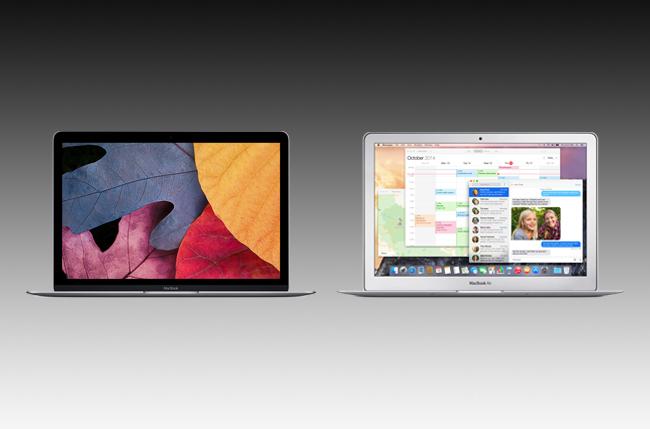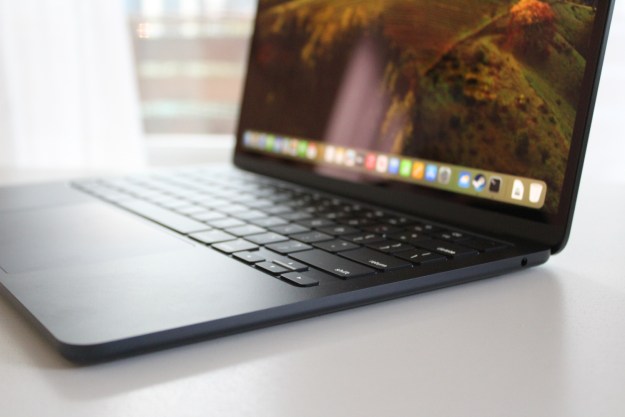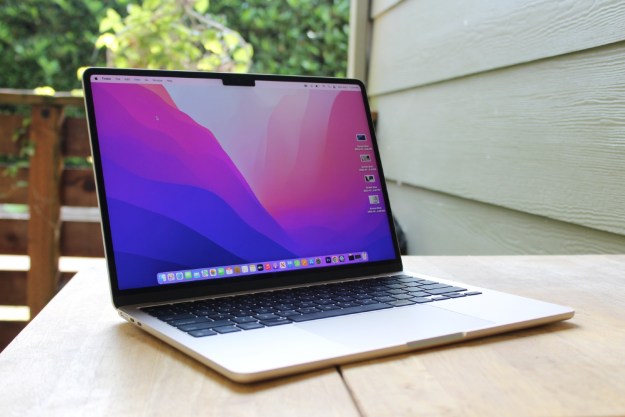
The refreshed Air will also retain the same 1,440 x 900-pixel display, which is mediocre at best, but a machine with underwhelming screen resolution isn’t necessarily worse in all facets. Check out the direct spec comparison below for a closer look at the internal hardware and exterior design of each offering, whether talking the edge-to-edge glass display on the MacBook or the 720p FaceTime camera.
|
2015 MacBook |
2015 MacBook Air (13-inch)  |
|
| Dimensions | 11.04 x 7.74 x 0.14-0.52 (in) | 12.80 x 8.94 x 0.11-0.68 (in) |
| Weight | 2.03 pounds | 2.96 pounds |
| Keyboard | Full size, backlit keyboard | Full size, backlit keyboard |
| Processor | 1.1GHz dual-core Intel Core M processor (4MB Cache, up to 2.4GHz) | 1.6GHz dual-core Intel Core i5 (3MB Cache, up to 2.7GHz) |
| RAM | 8GB of 1600MHz LPDDR3 | 4GB of 1600MHz LPDDR3 |
| Graphics | Intel HD Graphics 5300 | Intel HD Graphic 6000 |
| Display | 12-inch LED-backlit display with IPS technology | 13.3-inch LED-backlit display |
| Resolution | 2,304 x 1,440 | 1,440 x 900 |
| Storage | 256GB PCIe-based onboard flash storage | 128GB PCIe-based flash storage |
| Networking | 802.11ac, Bluetooth 4.0 | 802.11ac, Bluetooth 4.0 |
| Ports | USB-C, minijack | USB 3.0, Thunderbolt 2, SDXC card slot, minijack |
| Webcam | 480p FaceTime camera | 720p FaceTime camera |
| Operating System | Mac OS X Yosemite | Mac OS X Yosemite |
| Battery | 39.7-watt-hour | 54‑watt‑hour |
| Color offerings | Silver, Space Gray, Gold | Silver |
| Price | $1,300+ | $1,000+ |
| Availability | April 10 | Now |
| Review | Coming soon | 4 out of 5 (2013 model) |
Specifications
At first glance, the most apparent difference between the redesigned MacBook and the updated Air is the design. However, it’s what’s kept under the hood that truly differentiates the two high-end laptops. First off, the MacBook comes outfitted with an Intel M Core processor, a device that essentially trades processing power for longer battery life and greater energy efficiency.
The M Core processor likely not as capable as the Core i5 processor housed in the Air, meaning it’s not going to be as proficient when it comes editing photos or video. The 2015 MacBook does boast double the amount of storage and RAM, though, allowing for a greater amount of storage space and better efficiency when it comes to multitasking. Others facets, specifically networking, are the same across both machines, with each offering 802.11ac Wi-Fi and Bluetooth 4.0.
The port selection on each laptop is a completely different story, though. Whereas the Air comes outfitted with two USB 3.0 ports, a Thunderbolt 2 port, a SDXC card slot, and a minijack port, the new MacBook consolidates a bevy of traditional ports into a single offering known as USB-C . The connection features a reversible plug socket and can be used to both charge the system and connect storage, but sadly, it also forces most consumers to opt for a dedicated adapter if they want to connect their machine to more than one device at a time.
The Air shines in terms of battery life, too. The 13-inch machine touts a 54-watt battery, which Apple claims allows for up to 12 hours of web browsing and video playback. However, even with the updated chassis and tiered battery design, the new MacBook is only poised to last around 10 hours or so when web browsing or nine while playing video. The Air also trumps the MacBook with Intel HD Graphics 6000 and a 720p FaceTime camera, opposed to the MacBook’s Intel HD Graphics 5300 and meager 480p webcam.
The Air may look better on paper in some categories, but not so much in the display department. Many industry insiders and consumers were hoping Apple would implement its lauded Retina display within the next iteration of the Air, but as Cook & Co. were quick to point out during the company’s recent press conference, only the new MacBook will be retrofitted with the 2,304 x 1,440-pixel display. The Air will still utilize the same 13.3-inch LED-backlit display which we’ve grown accustomed to, offering a mere 1,440 x 900 pixels worth of resolution.
Design
Needless to say, there are striking design contrasts between the MacBook and the Air. In essence, the refreshed MacBook showcases the same aluminum uni-body construction of the Air, only it’s substantially thinner and lighter than its like-minded counterpart. It measures a mere 0.52 inches at its thickest point and weighs just over 2 pounds, while the Air measures 0.68 inches at its thickest point and weighs nearly 3 pounds.
The fan-less build of the MacBook also allows it to do away with the fan vents hidden in the Air’s hinge, and ultimately, lets it achieve its oh-so-sleek frame. The smattering of colors in which the MacBook is available — silver, space gray, and gold — only broaden it’s appeal in the same way Apple did with the iPhone 5S.
However, the MacBook also features a redesigned keyboard and trackpad. The full-size keyboard on MacBook features butterfly switches instead of traditional scissor-switch mechanisms, which Apple claims adds greater stability and allows for a better distribution of force when typing. The touchpad, on the other hand, features haptic feedback and uses corner-mounted force sensors to provide you with a more uniform click no matter where you press down.
The Air utilizes the same backlit keyboard it always has, one that is slightly smaller than full-size and uses the entire surface as a levered button. The updates to the keyboard and touchpad aren’t revolutionary, especially to those who have no qualms with the keyboard on the Air, but it still remains worth noting.
Availability
Regardless of your preference, you don’t have to wait longer for either offering. The MacBook is set for release on April 10, starting at $1,300, while the newly-announced Air is already on sale through Apple’s website starting at $1,000.
However, it’s important to keep in mind that the above comparison is based on a 13-inch Air and the base configuration — the cheapest iteration — of the forthcoming MacBook. The baseline, 13-inch Air may not be the most comparable in terms of price, but it touts all the aforementioned features and hardware for a mere $1,000.
You can always opt for a better-equipped Air if you’re in need of additional storage, or the cheaper offering if you don’t mind taking a hit when it comes to screen size and battery capacity. There’s also the 11-inch Air, which starts at $900, but of course has a smaller display.
Conclusion
The MacBook Air is probably a better deal. It boasts more processing power and a better selection of ports, not to mention longer battery life and better graphics capabilities.
The base configuration of the new MacBook does offer a healthy amount of RAM and a beautiful Retina display, along with an ultra-thin exterior, but neither hallmark is going win over most consumers when the 13-inch MacBook Air is priced $300 lower.
Design is the MacBook’s selling point, and the wild card. It’s beautiful, it’s thin, it’s light. If you want the coolest notebook around it’s the way to go. From a practical standpoint, though, the Air has an advantage.
Editors' Recommendations
- The 5 best MacBooks for video editing in 2024
- The best MacBook to buy in 2024
- Best laptop deals: Save on the Dell XPS 14, MacBook Pro 16 and more
- Best Apple deals: Save on AirPods, Apple Watch, iPad, MacBook
- The MacBook Air 15 vs. MacBook Pro 14: the easy way to decide





